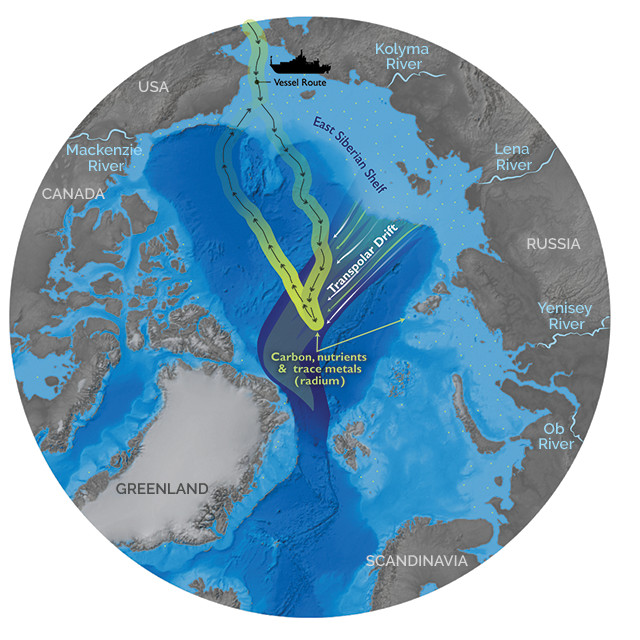
by Bethany Augliere Tuesday, April 10, 2018

In 2015, researchers measured radium in the Arctic Ocean from the Chukchi Shelf (where the voyage started) to the North Pole. Elevated radium levels (shown in bright yellow along the cruise route) were found near the North Pole, possibly as a result of transport from the East Siberian Arctic Shelf. Credit: Natalie Renier, Woods Hole Oceanographic Institution.
Rising temperatures have already caused changes in the Arctic environment, like diminishing sea ice and thawing permafrost. Now, it appears that sea-ice loss could be throwing Arctic Ocean chemistry out of whack.
In a new study in Science Advances, researchers suggest that, increasingly, materials like nutrients and trace metals are mixing into the Arctic Ocean from continental shelf sediments. This could disrupt the Arctic food web, affecting organisms from tiny phytoplankton up to polar bears, says lead author Lauren Kipp, a chemical oceanographer at Woods Hole Oceanographic Institution in Massachusetts. “Changes are already happening in this region,” Kipp says. “It’s important for us to understand and monitor how [they] are happening, so that we can predict how the Arctic will change in the future.”
In 2015, working aboard the U.S. Coast Guard icebreaker Healy, Kipp and her team sampled Arctic surface waters at 69 sites from the Chukchi Shelf to the North Pole; they also sampled vertical profiles of the water column at 20 sites. The scientists then measured concentrations of radium in each sample. Radium is produced naturally by the decay of thorium isotopes, which occurs in rocks and soils. Unlike thorium, however, radium dissolves in water. “It’s added to the ocean when seawater encounters the coastline or continental shelf sediment,” Kipp says. So “the radium acts as a tracer of shelf inputs to the ocean.”
The researchers found surprisingly elevated radium levels in parts of the Arctic, including near the North Pole where concentrations had doubled compared to measurements taken in a 2007 study, as well as near the Chukchi Shelf. “We expected [radium concentrations] to be the same,” Kipp says, because sources and sinks of nutrients and chemicals in the ocean are typically balanced and consistent over time — remaining stable for up to millennia for certain elements like sodium and chloride. For radium, in particular, the researchers didn’t expect to see an increase over just a decade. The radium levels Kipp and her team found were also 10 times higher than they are in the Atlantic Ocean.
It’s not clear why radium concentrations have doubled, Kipp says, but she and her co-authors suspect that shrinking sea-ice coverage in the Russian Arctic has something to do with it. As ice retreats from the East Siberian Arctic Shelf — the largest continental shelf on Earth — surface waters there are more exposed to wind, which, in turn, can lead to more mixing in the water column over that shelf, she says. Once shelf sediments are mixed into the water, they can travel from Russia, via the Transpolar Drift Current, to the central Arctic, where increased radium levels were detected. “These shelves are really shallow,” Kipp says. “On average, they’re about 50 meters deep, so it doesn’t take much to increase the communication between the sediment and the water column.”
Radium in the Arctic Ocean may have other sources as well, like meltwater from thawing permafrost or rivers carrying eroded sediment from the land surface, but Kipp’s team calculated that those contributions are small compared to shelf sediments. “Right now, the best evidence [of high radium in the Arctic Ocean] is consistent with what she [Kipp] describes in her paper,” says Robert Anderson, a chemical oceanographer from Columbia University’s Lamont-Doherty Earth Observatory, who was not involved in the new study.
Kipp says she wants to figure out the rate at which the radium concentrations in the Arctic are increasing and to confirm where exactly the radium is coming from. “Is this a widespread phenomenon, or happening in just one place?” she asks.
“There’s a real need for measurements on the Siberian shelf,” Anderson notes, because it’s the widest shelf and the biggest source of sediment-derived inputs to the Arctic Ocean. But access to Russian territorial waters has been historically difficult. He says he hopes Russian scientists will take the lead on this work, because collaboration is “going to be key to understanding the changes going on in the Arctic.”
© 2008-2021. All rights reserved. Any copying, redistribution or retransmission of any of the contents of this service without the expressed written permission of the American Geosciences Institute is expressly prohibited. Click here for all copyright requests.